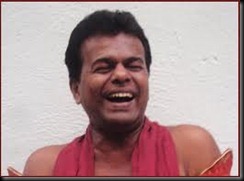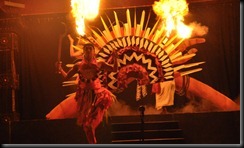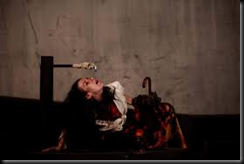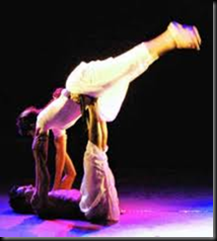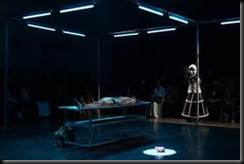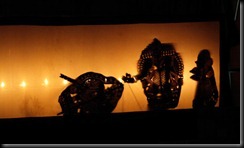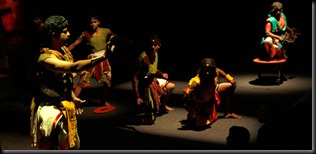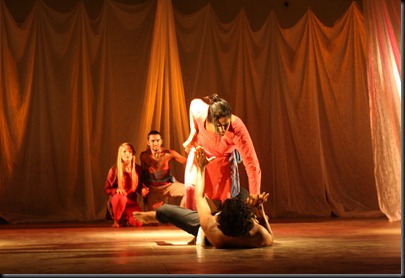 The project from North Karelian arts council to Lokadharmi for a collaborative workshop with artists from Finland and Lokadharmi to end in a production was accepted with an open mind but was a challenge in itself. Only seven days from the start, and on the seventh day on stage for the show! And we have artists meeting for the first time, from alien cultures, different tradition of performance, different work methodology and different sensibilities; who cannot understand the language each other. Actors, and musicians meeting for the first time; the only consoling aspect was that I knew Tuire Hindikka and Pirkko Kurikka, the director and playwright from Finland and that they knew me and my theatre. We share something in common; we both work mostly with improvisation with actors to create the play, and would love to use the actor as the source and means of our theatre.
The project from North Karelian arts council to Lokadharmi for a collaborative workshop with artists from Finland and Lokadharmi to end in a production was accepted with an open mind but was a challenge in itself. Only seven days from the start, and on the seventh day on stage for the show! And we have artists meeting for the first time, from alien cultures, different tradition of performance, different work methodology and different sensibilities; who cannot understand the language each other. Actors, and musicians meeting for the first time; the only consoling aspect was that I knew Tuire Hindikka and Pirkko Kurikka, the director and playwright from Finland and that they knew me and my theatre. We share something in common; we both work mostly with improvisation with actors to create the play, and would love to use the actor as the source and means of our theatre.
We started working together with a thin storyline from Kalevala, the Finnish national epic; which is to be: “there are two main themes in this: mother's love (which does not finally change the son's fate) and son's arrogance (which creates destruction)” as Pirkko scribbled to me in her first note.
 The participating artists were Eija Jalkanen, Mari Kortelainen, Anna Venalainen, Martta Hyytiainen, Janne Hyytiainen, (from Finland) along with Charu Narayanan, Adithye K Narayanan and Selvaraj VR(from Lokadharmi); and musicians Laura Vuorjoki-Elo, Mammu Koskelo Kishore NK ; Antti Koukonen as the sound technician .The lighting designer Gireesh Menon joined later. The play is to be directed by me and Tuire Hindikka with supports by Pirkko Kurikka. I decided that the role of the director was to facilitate the devising of the play and orient the actors towards meeting a common performance culture and style.
The participating artists were Eija Jalkanen, Mari Kortelainen, Anna Venalainen, Martta Hyytiainen, Janne Hyytiainen, (from Finland) along with Charu Narayanan, Adithye K Narayanan and Selvaraj VR(from Lokadharmi); and musicians Laura Vuorjoki-Elo, Mammu Koskelo Kishore NK ; Antti Koukonen as the sound technician .The lighting designer Gireesh Menon joined later. The play is to be directed by me and Tuire Hindikka with supports by Pirkko Kurikka. I decided that the role of the director was to facilitate the devising of the play and orient the actors towards meeting a common performance culture and style.
The story line as it evolved
Far in the North young maidens are playing on the shore. One of them is the daughter (Anna Venalainen) of Louhi (Charu Narayanan), mighty female shaman of the North. The daughter is dancing with her fiancée (Adithye K Narayanan) and the other girls teasing them.
Suddenly there comes Lemminkainen (Selvaraj VR), a charming stranger. He falls in love with Louhi’s daughter. Both the fiancée and Louhi fight with him. Louhi humiliates him and despises him, because of his humble birth in a lower race.
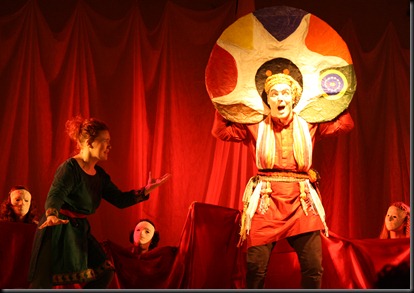 Lemminkainen returns home, but cannot forget the maiden in the North. Is spite of his mother’s (Eija Jalkanen)and wife’s (Mari Kortelainen )warnings he decides to return to the North to get the girl. He leaves mother with his hair brush, saying arrogantly: “When this brush bleeds, then you know I have been killed”
Lemminkainen returns home, but cannot forget the maiden in the North. Is spite of his mother’s (Eija Jalkanen)and wife’s (Mari Kortelainen )warnings he decides to return to the North to get the girl. He leaves mother with his hair brush, saying arrogantly: “When this brush bleeds, then you know I have been killed”
Louhi’s daughter is tempted by Lemminkainen the fiancé enters, and there arises a battle between the two men. Louhis daughter gets killed during the battle, by accident. When Louhi finds her daughter dead, she kills Lemminkainen with her magical weapons.
In the realm of death, the King (Janne Hyytiainen) receives the two dead pwrsons, they become part of the River of Death.
Louhi comes to beg her daughter back to life, saying that the girl was innocent, and she as a mother guilty. The King denies, and Louhi must go. Lemminkainen’s mother also comes for her son. She begs the King to get her son back, because he has not fulfilled all the tasks meant for him. She offers herself to the River of Death (Martta Hyytianen), instead of her son. Finally she shows the King his hair brush, still bleeding. “If your son still bleeds, he is not dead. Take him away.”
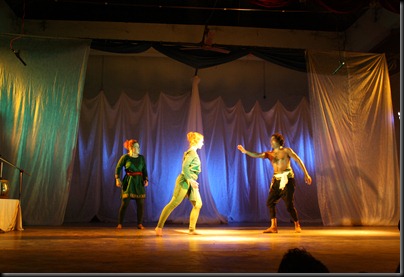 Lemminkainen returns home. The loving wife is happy to get him back. But in a short moment everything changes, when Lemminkainen tells that he has to return to the North, to meet bigger challenges and other beautiful women. Mother tries to stop him, as she is convinced that his life will be destroyed in the North.
Lemminkainen returns home. The loving wife is happy to get him back. But in a short moment everything changes, when Lemminkainen tells that he has to return to the North, to meet bigger challenges and other beautiful women. Mother tries to stop him, as she is convinced that his life will be destroyed in the North.
The son leaves the home again; the mother has taken him back from the realm of Death, but he has not given up his visions about new life, far away in North.
The play ends with a Finnish song, which means, “Death is the final resort, death is the final consolation and is the abode of peace…” which was sung by all the cast.
The process
We started work trying to explore each other’s body dynamics, movement pattern, potentials and inclinations in acting. Charu initiated the workshop with Yoga and Kalari based movements which the Finnish girls adapted very easily. In return Mari and Anna who are dancers reciprocated with movements from their repertory. Selvaraj initiated movements with singing and in rhythm. In the improvisation Eija came with strong and powerful expressions and emotions. The work developed very fast and the mutual inclusion was instantaneous.
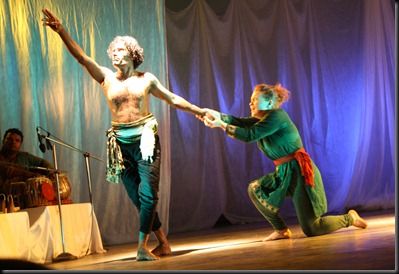 We had movement sessions, improvisations, and discussions. We don’t want to re-narrate the story from Kalevala (even if it reflected episodes and characters from Indian epics), but was looking into the story and extract the meaning of it, for us living in this time. Anna told me that the story is about the violence that is happening inside contemporary Finnish houses. In Finland there is not that much violence out in the society; but there is much violence inside the four walls of the house. Most of the murders are domestic; husbands, wives, lovers, in-laws, parents and brothers, kill each other. In our story also there are two murders… one a fiancée killing his love and the Louhi killing Lemminkainen who was the reason for the death of her daughter. These two murders were giving us the opportunity to look into the relations and contemporary violence that happen in Finland, India or elsewhere. We had the contemporary situations, incidents, and happenings in our mind when we created the emotional progression of the story and its interpretation. The story of Kalevala was instrumental in understanding the current relationships, affairs, disintegration of family, the betrayal and dissatisfaction that creeps into marital life.
We had movement sessions, improvisations, and discussions. We don’t want to re-narrate the story from Kalevala (even if it reflected episodes and characters from Indian epics), but was looking into the story and extract the meaning of it, for us living in this time. Anna told me that the story is about the violence that is happening inside contemporary Finnish houses. In Finland there is not that much violence out in the society; but there is much violence inside the four walls of the house. Most of the murders are domestic; husbands, wives, lovers, in-laws, parents and brothers, kill each other. In our story also there are two murders… one a fiancée killing his love and the Louhi killing Lemminkainen who was the reason for the death of her daughter. These two murders were giving us the opportunity to look into the relations and contemporary violence that happen in Finland, India or elsewhere. We had the contemporary situations, incidents, and happenings in our mind when we created the emotional progression of the story and its interpretation. The story of Kalevala was instrumental in understanding the current relationships, affairs, disintegration of family, the betrayal and dissatisfaction that creeps into marital life.
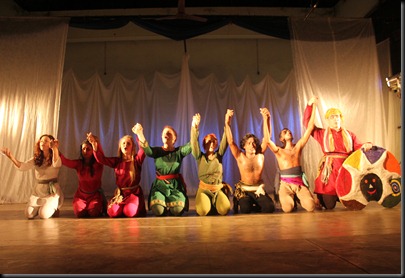 For me, the disintegration of the social structure based on closed family system has become a continued obsession in my plays. It started somewhere in the production of Medea, and Abhayarthikal by G Sankara Pillai was a profound articulation into the treachery, falsehoods, fragility and meekness of the secluded family system. That play had a very Ibsenesque structure where the female vs male conflict breaks the family structure so that the heroine celebrates her freedom and self-respect by opting out of the walls of the so called ‘happy home’. The sequences with Ravana and Mandodari in Lankalakshmi also had undercurrents of deceit and make belief that keeps the family ties on. In the current play Draupadi (in rehearsal) this theme is more closely and intensely looked into. In all these plays I approached the state of affairs from the female point of view, the marginalised entity in the whole business. In the play ‘Two mothers in the Realm of Death’, the same theme is repeating, but looked from a more neutral point of view. A strong male figure is absent except Lemminkainen, who is like a modern youth charmed by passion and beautiful girls around. Louhi’s daughter also shifts her love from her fiancée to Lemminkainen, when she sees that this new man is more heroic, fashionable and charming than her old lover. Love, attraction and bonding are so docile and can change with a slight reason. It is just unreasoned passion and blind dreams that guides the characters.
For me, the disintegration of the social structure based on closed family system has become a continued obsession in my plays. It started somewhere in the production of Medea, and Abhayarthikal by G Sankara Pillai was a profound articulation into the treachery, falsehoods, fragility and meekness of the secluded family system. That play had a very Ibsenesque structure where the female vs male conflict breaks the family structure so that the heroine celebrates her freedom and self-respect by opting out of the walls of the so called ‘happy home’. The sequences with Ravana and Mandodari in Lankalakshmi also had undercurrents of deceit and make belief that keeps the family ties on. In the current play Draupadi (in rehearsal) this theme is more closely and intensely looked into. In all these plays I approached the state of affairs from the female point of view, the marginalised entity in the whole business. In the play ‘Two mothers in the Realm of Death’, the same theme is repeating, but looked from a more neutral point of view. A strong male figure is absent except Lemminkainen, who is like a modern youth charmed by passion and beautiful girls around. Louhi’s daughter also shifts her love from her fiancée to Lemminkainen, when she sees that this new man is more heroic, fashionable and charming than her old lover. Love, attraction and bonding are so docile and can change with a slight reason. It is just unreasoned passion and blind dreams that guides the characters.
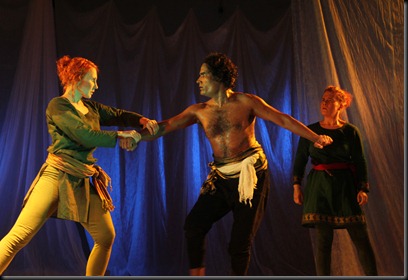 In contrast the mothers are trying hard to keep the family structure and the social order intact. They have to argue, fight (even physically), plead and cry to keep the status quo maintained for a smooth life, but both the mothers ultimately fail leaving life as a tragedy.
In contrast the mothers are trying hard to keep the family structure and the social order intact. They have to argue, fight (even physically), plead and cry to keep the status quo maintained for a smooth life, but both the mothers ultimately fail leaving life as a tragedy.
The two mothers play important roles in this play. One is highly physical, a shaman, with magical weapons and innate strength, but fails to convince the King in the realm of Death. She has to be more physical in her expression; Charu with her Kalari tradition did the role with sharp, quick movements and with intense passion that suits the strength and mobility of the character. The mother of Lemminkainen is more passionate, conformist, and more human. She is arrogant with her son; pleads and cries to convince others. Eija came with a very powerful emotive presence on stage, with loads of emotions, involvement, energy and passionate physical attributes to suppliment. The two mothers ruled the stage with different approaches, equally gripping and powerful. It was the journey to the same situation from two diagonal positions; the journey through two different paths from different perceptions, reaching almost at the same place, done with the same intensity.
 Selvaraj could use his own skills gathered by his long experience in theatre, to make Lemminkainen convincing. His passion, determination, restlessness, dream about a more charming life, inferiority complexes, arrogance and an innate thirst to hunt in newer meadows was clear. He used his sense of music, rhythm, movement, physical agility, along with his stage presence in portraying this character. At the same time I noticed that he was more expressive and intense than his usual style of acting, may be reciprocating to the western counterparts in equal terms. This is one achievement of this workshop and this production. There was good give and take between actors, mutually supplementing and supporting; influencing each other, so that the blend was more spontaneous. Charu, Adithye and Selvaraj used more intense facial expressions, more connected to the inner character than usual, spontaneous and genuine, yet keeping the physicality of the performance intact. The actors from Finland on the other hand responded to the fluidity of movement and physicalization of their Indian counterparts, keeping the facial and emotional expression as their innate strength. Mari and Anna being dancers could easily adapt to the movement and choreography, develop it further to create fluidity, transcending to the visual poetry. Adithye and the Finnish girls seemed to create a very passionate movement pattern, beautiful to watch, improvising on stage, mutually enjoying and alert to each other and at the same time communicating to the audience without the use of words or spoken lines.
Selvaraj could use his own skills gathered by his long experience in theatre, to make Lemminkainen convincing. His passion, determination, restlessness, dream about a more charming life, inferiority complexes, arrogance and an innate thirst to hunt in newer meadows was clear. He used his sense of music, rhythm, movement, physical agility, along with his stage presence in portraying this character. At the same time I noticed that he was more expressive and intense than his usual style of acting, may be reciprocating to the western counterparts in equal terms. This is one achievement of this workshop and this production. There was good give and take between actors, mutually supplementing and supporting; influencing each other, so that the blend was more spontaneous. Charu, Adithye and Selvaraj used more intense facial expressions, more connected to the inner character than usual, spontaneous and genuine, yet keeping the physicality of the performance intact. The actors from Finland on the other hand responded to the fluidity of movement and physicalization of their Indian counterparts, keeping the facial and emotional expression as their innate strength. Mari and Anna being dancers could easily adapt to the movement and choreography, develop it further to create fluidity, transcending to the visual poetry. Adithye and the Finnish girls seemed to create a very passionate movement pattern, beautiful to watch, improvising on stage, mutually enjoying and alert to each other and at the same time communicating to the audience without the use of words or spoken lines.
It was really interesting to create this play which turned out to be an ensemble effort, as in all devised productions. In the early stages, I was more observing, talking and inspiring actors to create. Slowly I found myself on my toes, moving along with the actors, physically involving in the scheme of things, trying to get into the skin of the actors, to provoke and persuade them to create, articulate precisely and fine tune the images, actions, and expressions. Looking back I found myself acting as the bridge between the two theatre styles to land in a common island. The rehearsals were very relaxed, peaceful and much creative and on the fifth day I was sure that we will come up with something interesting and worth to perform.
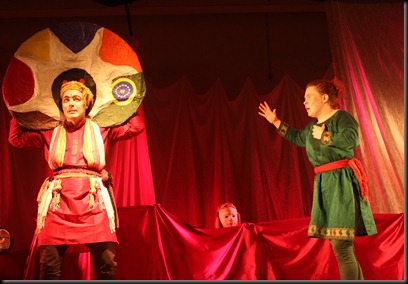 The one strategy that I adapted was that, we started with no dialogues and speeches, trying to perform the play without any spoken word; so the actors created visual images, movements and expressions to communicate the essence of the situation. It is on the fourth day after the blocking is finished that I asked actors to start speaking in their own languages; but they have to focus on the sonority and expression of the sound than the meaning of the spoken word. The audience has to understand the ‘meaning’ of the dialogue, from the context and expression. Music played a very important role in this phase, which was developing till the last day. There were beautiful moments of exchanges in Finnish and Malayalam, in modulated coloured the voices with expressiveness, punched with emotion, linked to the gestures and body language. And finally the lines were written and fixed, on the sixth day.
The one strategy that I adapted was that, we started with no dialogues and speeches, trying to perform the play without any spoken word; so the actors created visual images, movements and expressions to communicate the essence of the situation. It is on the fourth day after the blocking is finished that I asked actors to start speaking in their own languages; but they have to focus on the sonority and expression of the sound than the meaning of the spoken word. The audience has to understand the ‘meaning’ of the dialogue, from the context and expression. Music played a very important role in this phase, which was developing till the last day. There were beautiful moments of exchanges in Finnish and Malayalam, in modulated coloured the voices with expressiveness, punched with emotion, linked to the gestures and body language. And finally the lines were written and fixed, on the sixth day.
The very talented musicians Laura and Mammu along with Kishore contributed a lot to this production. They used vocal singing, created many sounds to match the dramatic situation, performed instruments like Melodica, Kantale and supplemented by percussion from Tabla, drums, djembe, udukku and different kinds of bells. The system of music, singing pattern, pitches, and rhythm, could meet and supplement to become the backbone of this performance never overruling the actors. Antti at the sound was creatively complementing the musicians by accentuating the effects created by them.
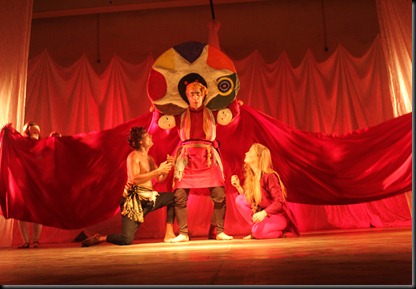 I have to write the experience of working with Janne Hyytianen, an exemplary actor in the Finnish film and theatre scenario. He is a very powerful and shrewd actor, true to himself who can create magical moments with subtlest of movements, changes in postures, voice modulations. On the first few days, he was so neutral and took a lot of time to respond and react, was asking for clarifications like, “can I turn now, what shall I do with my hands, can I move upto there’ etc. He was trying to understand assimilate the role, the orbit he can take, trying to understand the design and the freedom he could utilise etc. In this phase I almost felt that he has a slight hesitation to move and to be dynamic, but things started to change on the 5th day. Slight cues given to him were assimilated and enlarged, started improvising his movements and expressions, communicated to the rhythm with footwork and dance (it is astonishing to see him pouncing, jumping, dancing as if possessed by the music and the headgear like a Theyyam which he has not seen in his life). The suggestions like “enjoy the smell of blood, use tongue, laugh and be playful’ was elaborated to create the character. Actually I have not directed him directly, but was observing the graph with which he developed the character, and assimilated himself into the design of the play, quite smoothly, creatively and intelligently. He is one of such actors any director would love to work with.
I have to write the experience of working with Janne Hyytianen, an exemplary actor in the Finnish film and theatre scenario. He is a very powerful and shrewd actor, true to himself who can create magical moments with subtlest of movements, changes in postures, voice modulations. On the first few days, he was so neutral and took a lot of time to respond and react, was asking for clarifications like, “can I turn now, what shall I do with my hands, can I move upto there’ etc. He was trying to understand assimilate the role, the orbit he can take, trying to understand the design and the freedom he could utilise etc. In this phase I almost felt that he has a slight hesitation to move and to be dynamic, but things started to change on the 5th day. Slight cues given to him were assimilated and enlarged, started improvising his movements and expressions, communicated to the rhythm with footwork and dance (it is astonishing to see him pouncing, jumping, dancing as if possessed by the music and the headgear like a Theyyam which he has not seen in his life). The suggestions like “enjoy the smell of blood, use tongue, laugh and be playful’ was elaborated to create the character. Actually I have not directed him directly, but was observing the graph with which he developed the character, and assimilated himself into the design of the play, quite smoothly, creatively and intelligently. He is one of such actors any director would love to work with.
The play has 3 distinct locales in its storyline, the lush green pasturesque landscape of Lemminkainen by the side of the River of Life, the land of Louhi at the North, full of passion, warm with intense emotions and ecstasy of magic; and thirdly the Realm of Death by the River of Death. Gireesh Menon created the ambience of these spaces with changes of hues in lighting.
 Finally when on the seventh day the performance was premiered, me and all artists associated were happy and satisfied so as the audience who witnessed. The Indian artists may travel to Finland next year to work with the same artists and take the production ahead, if things work out.
Finally when on the seventh day the performance was premiered, me and all artists associated were happy and satisfied so as the audience who witnessed. The Indian artists may travel to Finland next year to work with the same artists and take the production ahead, if things work out.
The workshop was exhaustively documented by Jebin Jesmes, and the production done by Anna Susitaival, for North Karelian Art Council Finland, coordinated by Pradeep Sukumar, and supported by Chavara Samskarika Kendram.
Photos: Shobha Menon, & Jolly Antony
Labels: Chandradasan, Lokadharmi, Two mothers in the realm of Death
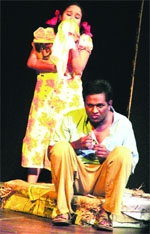
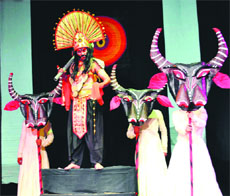


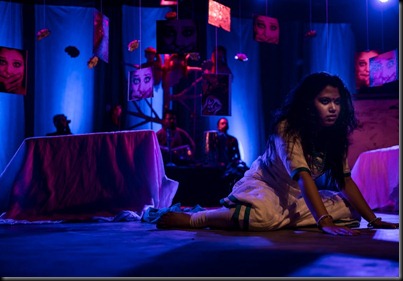


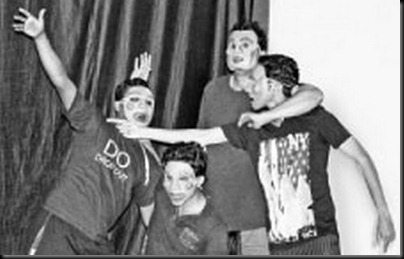

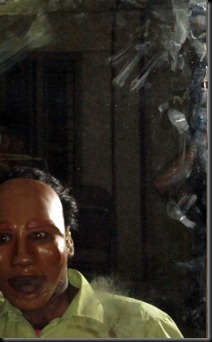

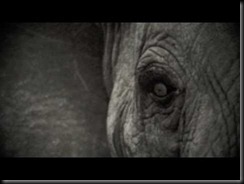
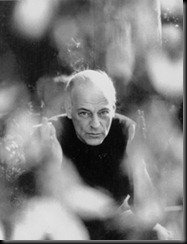 Brooklyn, New York
Brooklyn, New York
 Lokadharmi Theatre Group’s ‘Draupadi,’ to be staged tomorrow will look into the various shades of the epic character | EPS
Lokadharmi Theatre Group’s ‘Draupadi,’ to be staged tomorrow will look into the various shades of the epic character | EPS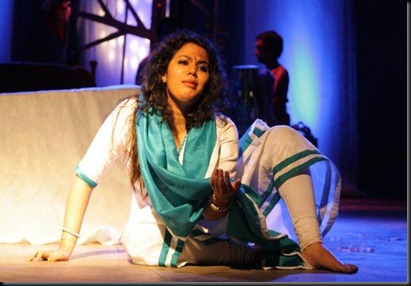
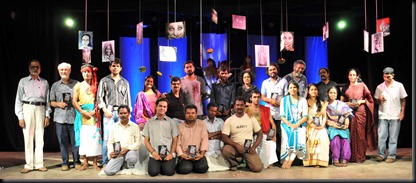
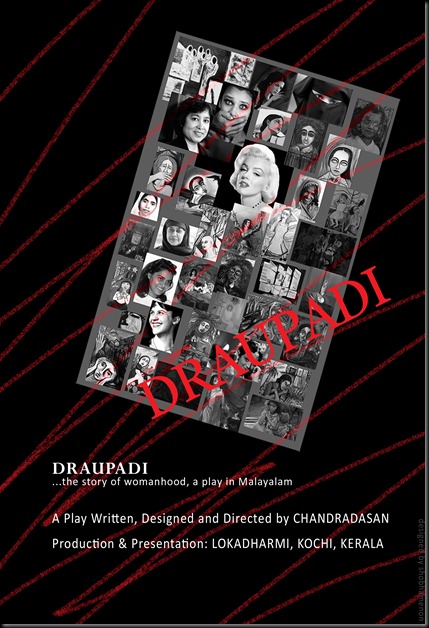
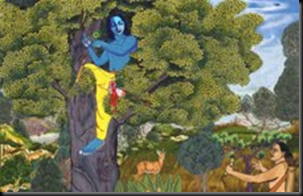
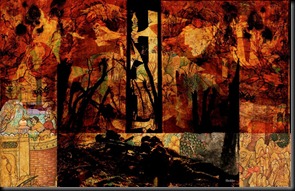











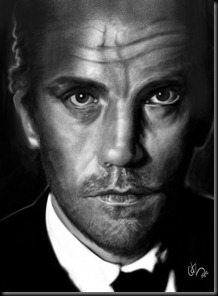
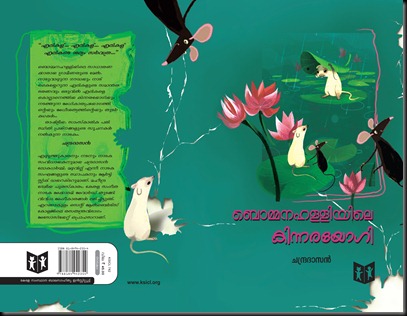
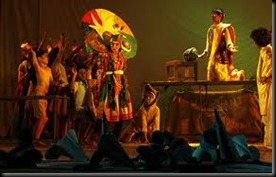
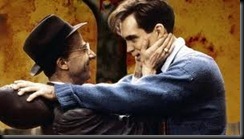

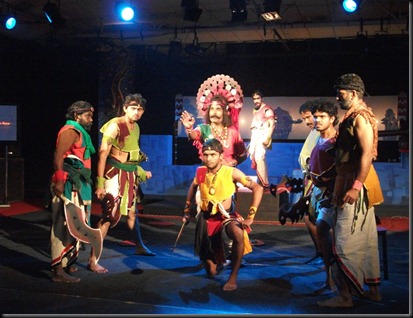


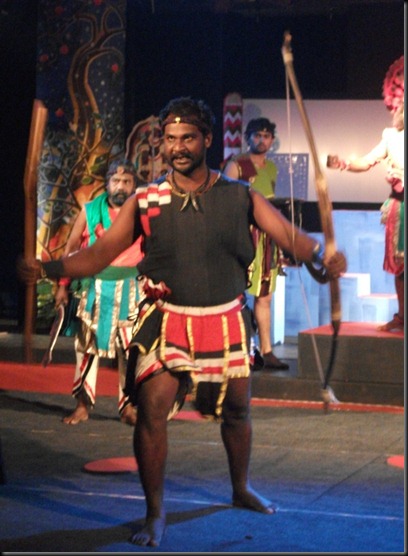
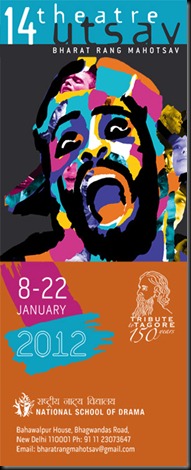
![lankalaksmi[3] lankalaksmi[3]](http://lh3.ggpht.com/-uhj4purMs3Q/TwC4W-9PxQI/AAAAAAAAAyQ/9V4opBeCylg/lankalaksmi%25255B3%25255D_thumb%25255B2%25255D.jpg?imgmax=800)
